Hello, I’m Michael Zhang — a seasoned Chinese traveler with years of international experience exploring the world’s most culturally rich destinations. I have always been fascinated by places that allow visitors to truly understand history, not just see it. In every museum I visit, I try to “read” the soul of a city through its artifacts. Among all the museums I’ve explored, the Nanjing Museum stands out as one of the most captivating cultural institutions in China. It’s a place where you can trace the threads of Chinese civilization across time. In this guide, I’ll take you through the museum’s history, architecture, and major exhibitions, helping you see why visiting the Nanjing Museum is about more than observing artifacts—it’s about understanding Nanjing itself.
Summary
Nanjing Museum Overview
The Nanjing Museum is a comprehensive institution dedicated to history and art. As one of China’s most important state-level museums, it plays a crucial role in preserving the cultural heritage of Nanjing. Originally established as the Nanjing Municipal Cultural Relics Custody Committee shortly after the founding of the People’s Republic of China, the museum oversees archaeological excavations of local sites and tombs, manages artifact protection, and curates an extensive collection of historical relics. Its exhibitions trace Nanjing’s evolution through every major stage of Chinese history, with a special focus on its legacy as an ancient capital.
The museum is located within the Chaotian Palace, the largest and best-preserved ancient architectural complex in the Jiangnan region. The name “Chaotian Palace” was personally bestowed by Emperor Zhu Yuanzhang in 1385, symbolizing “paying homage to heaven.” The current structures date back to the Qing Dynasty (1866) and cover an area of approximately 40,000 square meters.
- Address: 321 Zhongshan East Road, Xuanwu District, Nanjing (Apple Maps / Amap)
- Opening Hours: Tuesday to Sunday, 9:00 AM – 5:00 PM (last entry at 4:00 PM). Closed on Mondays, except for national holidays.
- Recommended Visiting Time: 3–4 hours
- Best Season to Visit: Year-round
- Ticket Prices: Free admission (reservation required)

Nanjing Museum Map
The Nanjing Museum consists of three separate buildings that house six main exhibition halls: the History Hall, Special Exhibition Hall, Digital Hall, Art Hall, Intangible Heritage Hall, and Republic of China Hall.
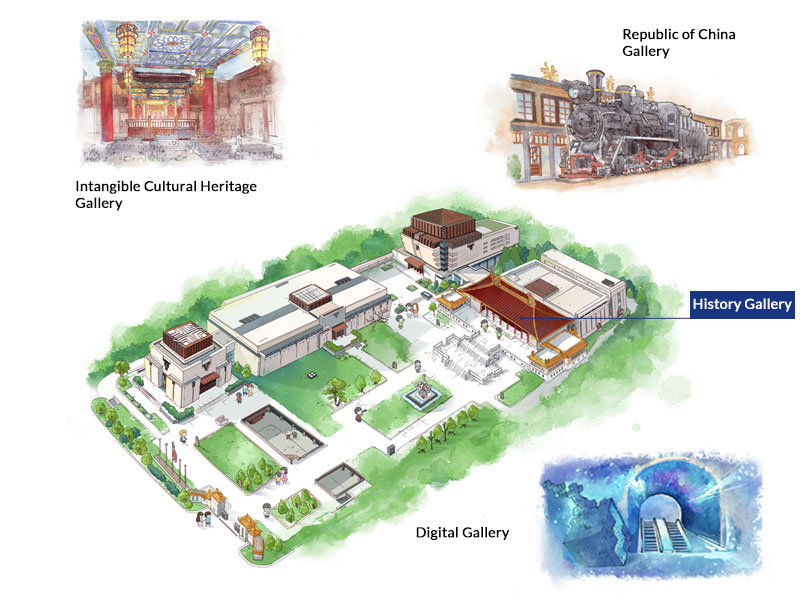
Why You Should Visit Nanjing Museum
Extensive Collection and Rare Artifacts
The Nanjing Museum holds over 430,000 artifacts, making it the second-largest museum collection in China—second only to the Palace Museum in Beijing (Forbidden City Travel Guide). Its exhibits cover a wide range of historical treasures, including bronzes, jade, ceramics, and calligraphy. Notable masterpieces such as the Western Han golden beast—the heaviest known gold artifact from ancient China—and the Tang Dynasty pink incense burner highlight the remarkable craftsmanship of their eras.
Six Thematic Exhibition Halls
- History Hall: Chronicles the evolution of ancient Jiangsu civilization through stone tools, bronze wares, and other relics that illustrate historical transitions.
- Special Exhibition Hall: Hosts rotating domestic and international exhibitions. In 2025, “The World of the Ming Dynasty” featured more than 400 artifacts from over 30 cultural institutions.
- Art Hall: Displays over 5,000 masterpieces including Song and Yuan paintings, Ming and Qing porcelains, and recreates Republican-era street scenes in the Republic of China Hall.
- Intangible Heritage Hall: Offers immersive hands-on experiences like paper cutting and embroidery, allowing visitors to craft their own traditional artworks.
Architecture and Cultural Experience
The museum’s architecture blends traditional and contemporary design, creating a harmonious balance between history and modernity. Within the Republic of China Hall, visitors can enjoy live tea-house performances, while tranquil courtyard cafés provide space to relax between exhibits. Meanwhile, the Digital Hall uses innovative technology to bring ancient stories to life through interactive displays, offering a truly engaging way to experience Chinese culture.
Top Things to Do in Nanjing Museum
Main Exhibition Halls
History Hall
Located at the very heart of the Nanjing Museum, the History Hall serves as the core exhibition area of the entire complex. The hall spans two floors with six galleries arranged chronologically, guiding visitors from prehistoric civilizations to the cultural splendor of the Ming and Qing dynasties. The exhibits vividly illustrate the evolution of Jiangsu’s ancient civilization—beginning with Impressions of the Ancient World and Prehistoric Charm, moving through Wu and Yue during the Spring and Autumn Period and The Glory of Regional Kingdoms, then into The Rise of the Six Dynasties, Tang Elegance, Jianghuai Vitality, Song and Yuan Dynamics, and finally reaching Prosperous Jiangnan and Ming-Qing Brilliance.
The collection includes many of the museum’s most treasured masterpieces, such as the Gold Cicada Jade Leaf, the Gold Threaded Jade Burial Suit, and the Seal of King Guangling, each a priceless testimony to the artistic excellence of ancient China.
- Gallery 1: Impressions of the Ancient World
- Galleries 2–6: Ancient Civilization of Jiangsu
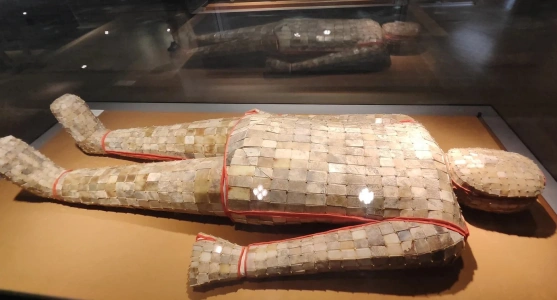
Special Exhibition Hall
The Special Exhibition Hall, encompassing Galleries 7 to 18, is the most dynamic and surprising section of the Nanjing Museum. It showcases both domestic and international themed exhibitions, along with curated displays of rare treasures from the museum’s own collection. Over the years, it has hosted a wide range of special exhibitions—such as Splendid Prosperity: Qing Imperial Kilns, Fine Clocks Exhibition, and Exploring Buddhist Sculptures—each drawing significant public and academic attention.
Many of the museum’s signature artifacts are also displayed here on rotation, including the Golden Beast, the Standing Gilded Guanyin Statue, and the Gilded Bronze Ink Box with Animal Motif, representing the pinnacle of craftsmanship and religious artistry in ancient China.
- Gallery 7: Children’s Experience Hall
- Gallery 8: Crescent and Rose (A Millennium of Iranian Civilization)
- Gallery 9: Protecting the World (Special Exhibition of the Golden Beast from Nanjing Museum)
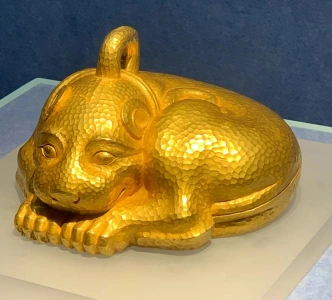
Digital Hall
The Digital Hall combines both physical and virtual experiences, marking the museum’s innovative step into digital cultural presentation. Using multimedia and immersive technologies, visitors can enjoy animated works such as Scenes of Prosperous Nanjing and engage with interactive games and AR experiences that recreate moments of ancient life. This fusion of tradition and technology allows visitors to explore Chinese civilization in entirely new ways.
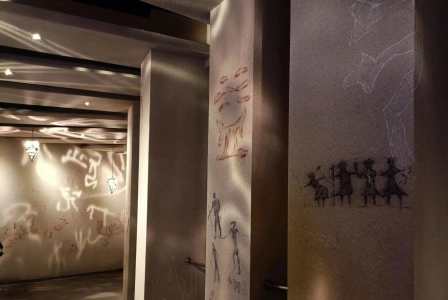
Art Hall
Home to Galleries 19 through 28, the Art Hall is a sanctuary of artistic brilliance, where masterpieces from different eras are displayed by material and artistic category. From sculpture and painting to calligraphy, the hall exhibits an extraordinary variety of works. Visitors can witness the evolution of sculpture across dynasties, appreciate the vitality of contemporary sculptor Wu Weishan, and enjoy the expressive colors of Su Tianci’s oil paintings alongside the exquisite brushwork of Fu Baoshi’s Chinese paintings.
- Gallery 19: Fu Baoshi Painting Gallery
- Gallery 21: Gallery of Historical Paintings
- Gallery 22: Chen Zhifo Art Gallery
- Gallery 23: Wuxi Huishan Clay Figurine Exhibition
- Gallery 24: Wu Weishan Sculpture Exhibition
- Gallery 25: Calligraphy from Past Dynasties
- Gallery 27: Su Tianci Oil Painting Exhibition

Intangible Cultural Heritage Hall
Located in the sunken plaza beneath the Art Hall, the Intangible Cultural Heritage Hall presents Jiangsu’s most important intangible cultural heritage through dynamic, live demonstrations. Here, visitors can observe traditional craftsmanship such as Nanjing Yunjin brocade weaving, gold foil hammering, and Yixing Zisha pottery making.
The hall also features regular live performances of traditional Jiangsu opera and folk arts, including Kunqu Opera, Baiju storytelling, and Suzhou Pingtan, creating a vibrant stage where the region’s living heritage comes alive.
- Gallery 31: Intangible Heritage Hall

Republic of China Hall
The Republic of China Hall, located in Gallery 30, offers one of the most immersive experiences in the Nanjing Museum. This section recreates the streets of Nanjing during the Republican era at a full 1:1 scale, allowing visitors to step back in time to a period of cultural fusion and social transformation.
A vintage tram runs through the recreated streets, lined with authentic shops from the era such as grocery stores, post offices, and the iconic Xianfeng Bookstore. The lively street scene captures the spirit of early 20th-century Nanjing. Visitors can take photos, browse for period-style souvenirs, and experience the nostalgic charm of “Old Nanjing.”
- Gallery 30: Republic of China Hall

Nanjing Museum Ticket Guide
Admission to the Nanjing Museum is free, but visitors are required to make an advance reservation through the museum’s official WeChat Mini Program. After completing the reservation, bring both the original ID used for booking and the confirmation proof (a screenshot of the successful reservation) to the green-channel service desk at the visitor center to enter.
- Ticket release time: Daily at 6:00 PM. Reservations can be made up to seven days in advance (excluding the same day) via the official WeChat Mini Program. Time slots are divided into morning (9:00 AM–1:00 PM) and afternoon (12:00 PM–4:00 PM).
- Children under 14 years old (inclusive) cannot reserve tickets independently and must be accompanied by an adult who books a Parent-Child Ticket. Each adult may bring up to three minors.
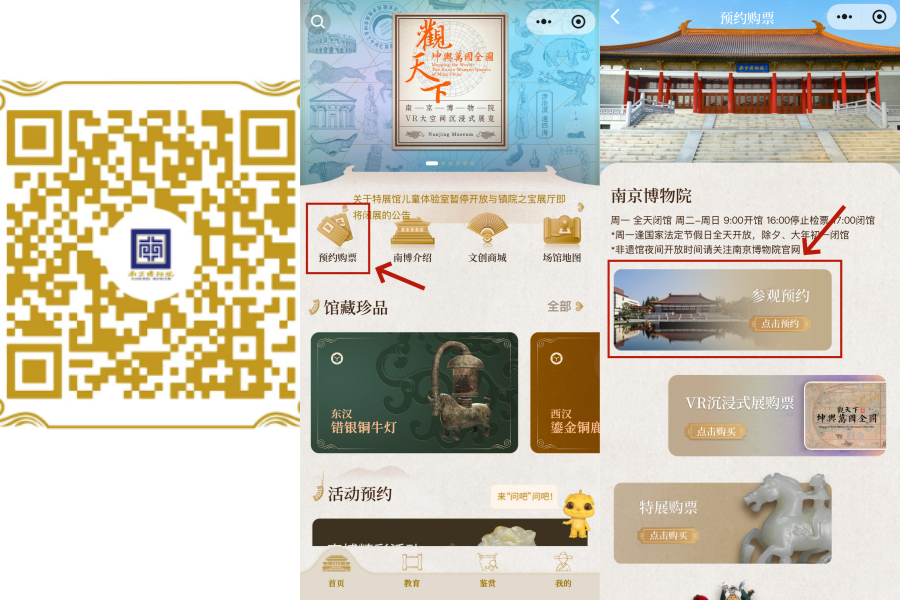
Nanjing Museum Audio Guide
The museum offers automatic sensor-based audio guides, which are quite practical and enhance the overall visiting experience.
- Rental fee: 20 CNY per device (mobile phone style)
- Coverage: All six main halls (excluding separately ticketed exhibits)
- Languages available: Chinese, English, Japanese, and Korean
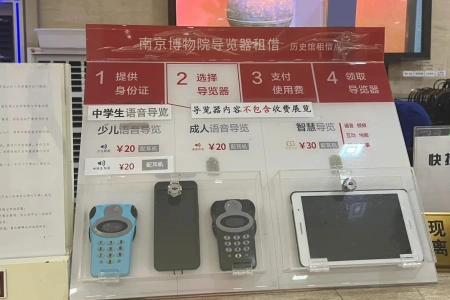
Recommended Nanjing Museum Visiting Route
The Nanjing Museum is extremely popular, so a smooth and efficient route can save time and ensure a great experience. The suggested route is: Art Hall → Republic of China Hall → Intangible Heritage Hall → Digital Hall → Special Exhibition Hall → History Hall. Exit from the central axis afterward to avoid backtracking. The route is simple, efficient, and ensures you won’t miss anything important.
Recommended Food Near Nanjing Museum
There are restaurants located within the museum—mainly inside the Republic of China Hall and the Special Exhibition Hall. The food quality is average but convenient for a quick meal, costing around 35 CNY per person, while cakes are about 50 CNY. For a better dining experience, head to the Houzaimen area, which is only a short walk from the Nanjing Museum and offers more authentic local cuisine.
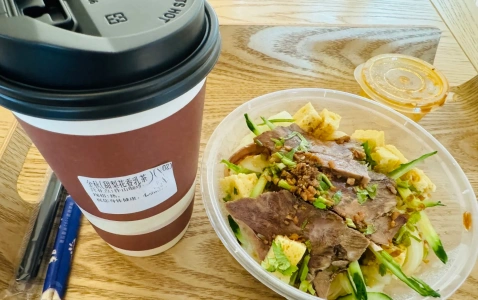
How to Get to Nanjing Museum from Downtown Nanjing
Taking the metro is the most convenient option. The Metro Line 2 goes directly to the museum area. For groups or families, taking a taxi or ride-hailing service is also affordable and quick in Nanjing.
Metro
Take Metro Line 2, get off at Minggugong Station, and exit from Exit 1. Walk east for about 300 meters to reach the Nanjing Museum. The metro fare is only 2 CNY.
Bus
Several bus lines stop near the museum, including Lines 5, 34, 36, 55, 59, and 80. Get off at Zhongshanmen Station, and you will see the Nanjing Museum right across the street.
Taxi / Ride-hailing
Located near the city center, the Nanjing Museum is easily accessible by taxi. The ride typically takes around 20 minutes and costs 15–20 CNY, depending on traffic conditions.
How to Get to Nanjing Museum from Nanjing Lukou International Airport
The metro is the most recommended way to reach the museum, as it’s more cost-effective and avoids the heavy traffic around the museum during peak seasons.
Metro
From Nanjing Lukou International Airport, take Metro Line S1 and transfer at Nanjing South Railway Station to Line 3. Get off at Daxinggong Station, then transfer to Line 2, and alight at Minggugong Station (Exit 1). Walk east for about 300 meters to reach the museum. The total fare is 8 CNY, and the journey takes approximately 1 hour and 30 minutes.
Taxi / Ride-hailing
A direct taxi from the airport to the Nanjing Museum costs about 70 CNY, including expressway tolls, and takes roughly 50 minutes under normal traffic conditions.
FAQ
Not entirely. Strollers and wheelchairs are permitted, but due to the presence of many stairs, some areas still require walking.
You can store luggage for free at the Visitor Center (turn left from the main entrance). There are also lockers available for larger items. One locker can fit a 20-inch suitcase plus a backpack with space to spare. The price ranges from 4 CNY / 2 hours to 8 CNY / 2 hours.

 English (US)
English (US)
 繁體中文
繁體中文 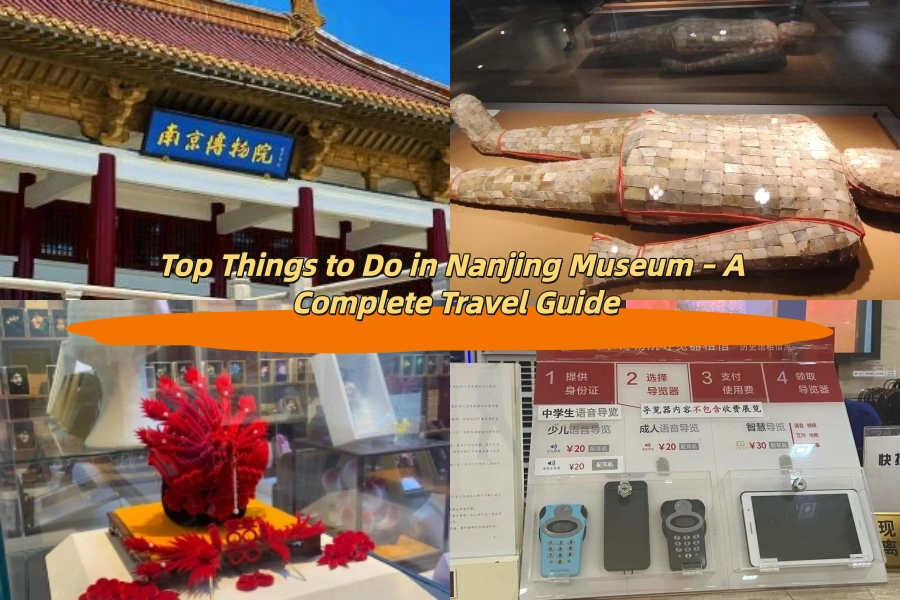
Comment (0)